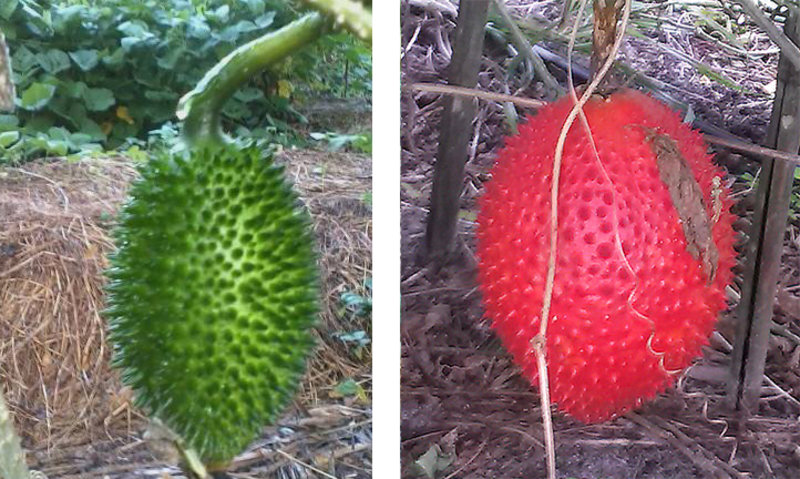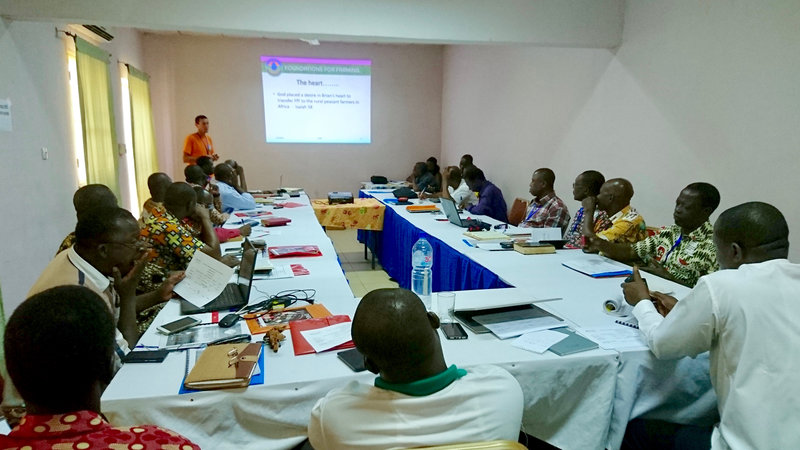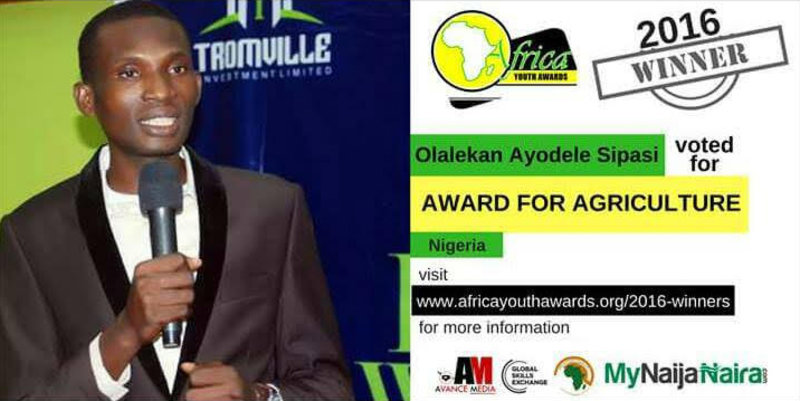ECHOcommunity更新
EDN Issue 135 - Now Available 2017-04-18
In This Issue:
Biofortified crops: What are they, how do they work and why should we grow them?
The cheers and challenges of Conservation Agriculture programs
Echoes from our Network: Woman and Agriculture feedback from Joel Matthews
From ECHO's Seed Bank: Gac - A colorful and health-promoting fruit
eBook Releases: Options for Restoring Unproductive Soils and Options Where Water is Scarce
Gac: A colorful and health-promoting fruit
From ECHO's Seed Bank
EXCERPT: Perennial leafy greens, such as moringa and chaya, have been featured quite extensively in EDN. Here we focus on the bright orange-to-red fruit (Figure 7) of a tropical vining plant called gac (Momordica cochinchinensis). Belonging to the Cucurbitaceae family, other names for gac are cochin gourd, spiny bitter cucumber, and sweet gourd. Gac fruit has a mild flavor. Like moringa, it can be consumed in a variety of ways; it can be eaten fresh, cooked, or as a powder. Incorporated into traditional foods, gac adds both color and nutrition.
Gac fruits are best known for their high concentration of carotenoids, natural chemicals that protect against cell damage and are the source of yellow, orange, or red coloring in fruits and vegetables. By weight, beta-carotene is more concentrated in gac fruit than carrots. Similarly, gac fruit has a higher concentration of lycopene than tomato. Much more detail about these and other health-enhancing properties of gac are available in the literature (Chuyen et al. 2015, Minh 2014).
Gac is currently available from the ECHO Global Seedbank
Check out the ECHO Plant Information Sheet on Gac
Experimenting with Medicinal Plants in Matagalpa Nicaragua 2017-04-11
Through many mistakes and trials, Sarah Hornsby, and husband Jim, learned much of the practical use of medicinal plants from their experience in Matagalpa, Nicaragua.
The reforestation project started with the purchase of land in the Arenal Forest Reserve. From there, the learning process began bringing to life the concept of “it takes a village to …” Neighbors were paid to help collect seedlings of native plants from surrounding forest to use in reforestation. Unfortunately, all five thousand neatly planted and labeled seedlings were planted on top of a hill where strong winds made it known the planting location was a mistake. Moving the seedlings to a more protected location invited other mishaps and lead to the creation of an informational website to share experiences and lessons learned.
The Power of Knowledge and Networking 2017-03-29
While at the gathering of 170 global participants working in agricultural and extension services, Abram met Saikou, who is from the Gambia and works as a Peace Corp volunteer coordinator and advisor for the Gambia. Saikou attended an ECHO Florida TAD 1 training back in 2014 to gain more knowledge about Tropical Agriculture Development. What he gained from the training was a wealth of options that he could help Peace Corps volunteers implement in the Gambia to improve smallholder farming households’ lives and food security. Upon returning to the Gambia, he began rolling out backyard chicken projects that employ local breeds and low-input feeds for sustainability. He has seen much success with the projects and communities are sharing the approach with each other and adoption is increasing. He credits ECHO, and in particular, the TAD 1 class, as being the inspiration, catalyst, and knowledge piece that makes the project successful.
ECHO Asia Research: Local treatments and vacuum sealing as novel control strategies for stored seed pests in the tropics 2017-03-22
Seed conservation under tropical climates is a great challenge when usual storage technology is lacking. Seed pests and the loss of seed viability are among the main risks faced by farmers and seed banks. Scientists Lawrence et. al. recently found that vacuum sealing significantly reduces stored insect pest pressure while maintaining seed viability. Several local treatments decrease also pest pressure, thus constituting sustainable alternatives to storage under low temperature and low moisture.
Asia Bruchids Vacuum Sealing Lablab Seed Treatment Seed Storage Germplasm
Amaranth as fish feed? - New research 2017-03-13
Scientists warn that global fish stocks are on the verge of collapse due to the effects of climate change and overfishing, fueling concerns of increased malnutrition. This not only translates into less fish for human consumption but, ironically, impacts aquaculture as commercial fish feed contains a large amount of fishmeal.
In an effort to identify a protein-rich replacement for fishmeal, researchers from Karatina University and the University of Eldoret in Kenya and the University of Arizona explored the use of amaranth (Amaranthus hybridus) leaves, which contain 17.5–30.3 percent dry matter as protein, of which 5 percent is lysine. Specifically, they replaced fishmeal with amaranth leaf protein concentrate (ALPC) for the production of Nile tilapia (Oreochromis niloticus). Through their research, it was determined that up to 80 percent of fishmeal could be replaced with ALPC without compromising growth performance and nutrient utilization.
Chaya use in West Africa 2017-02-28
K[] is a rural municipality located in the west of Burkina Faso. Ten years ago, an American missionary introduced Chaya which became a well-known and well-consumed leafy vegetable for the peasants of K[]. The peasants have made Chaya leaves a component of their diet which they consume in several different forms including leaf sauce, the leaves in peanut sauce, and they have incorporated it into other local dishes.
Resources on Parthenium 2017-02-15
Except: Parthenium hysterophorus, also known as carrot top, white top weed, and fever few is a fairly new invasive weed but has quickly become one of the worst weeds to tropical areas(CABI 2015). In Ethiopia it is known as Farmasissa which means “sign your land away” (IAPPS 2016). Originally from Central America, Parthenium has been seen to cause major problems in India and Southeast Asia, Australia, and East Africa. In 2015, Parthenium is said to have invaded roughly 34 countries globally (Strathie 2015). A fast growing highly reproductive invasive species, Parthenium has become a hazard to farmland, rangeland, as well as animal and human health. (From Parthenium hysterophorus by Emalee Allen)
Recent interest from ECHOcommunity network members has prompted the creation of new resources raising awareness of Parthenium.
In the network now: West African trainers meet for Foundations for Farming Training 2017-01-24
Knowing a subject is not enough to train on it, training adults requires specific competencies. This week in Burkina Faso, key trainers from across West Africa are meeting to improve their knowledge about the Foundations for Farming (FFF) method, and to improve their skills in sharing knowledge with others.
West Africa FFF Foundations For Ag... Foundations For Fa... Farmer Managed Nat... Training
ECHOcommunity Member Spotlight: Sipasi Olalekan Ayodele 2017-01-04
Sipasi Olalekan Ayodele is the most recent recipient of the Africa Youth Award for Agriculture. The CEO of L’Afrika Integrated Farms and ProtectOzone in Nigeria, he was nominated for the award based on his implementation of the Foundations for Farming methods, and for innovations at his poultry farm. Using locally available herbal alternatives he is demonstrating how to avoid the synthetic micronutrients in commercial poultry feed. Contamination in these feed products are linked to nearly a half-million lost birds each year. L’Afrika Integrated Farms, and those they have trained, are seeing decreased livestock mortality and improvements in the health and wellbeing of their consumers.
Greetings to the ECHOcommunity as we enter 2017 2016-12-27
Thank you for your participation with ECHO during the past year. You and your 11,000 other colleagues around the world constitute a unique Community of Practice. What makes you a “community of practice”? You share a passion to address the challenges of small-scale farmers, their agriculture, their health and their communities. And, you share a desire to learn how to do this more effectively – a desire to “get better”.
Because we share these passions and desires, we can learn from each other, support and encourage each other and collectively increase our beneficial impact. ECHOcommunity provides special opportunities for us to do all of this…together. It also provides a way that we can multiply our impact into places in the world where we might never set foot but where our experience can bless and benefit nonetheless.
As we enter 2017, I want to encourage you to make time for your “community of practice”, invest in it, and grow it. In the process we will all benefit. Please also let us know how we can more effectively nurture this very special community that we share – we’re passionate…and want to get better!
Thank you for being part of the ECHOcommunity!
David Erickson
President/CEO – ECHO, Inc.









